Most of the consultation and coaching sessions I do with our Mastermind members have one thing in common:
The belief that SCALE means “more products” and “more offers.”
Take it from a guy who built a publishing company: the “more products and more offers” strategy is THE most complicated way to SCALE a business.
LESS is MORE.
In fact, you can get to a $10 million business with as little as ONE offer and NO MORE than 4 offers. I’ll walk you through exactly what they are in this post.
But first, I want to tell you about our online community where you can learn from me and other successful entrepreneurs about how to scale your business. Join our free Expert Scale Facebook Group today!
Horizontal Vs. Vertical Scaling
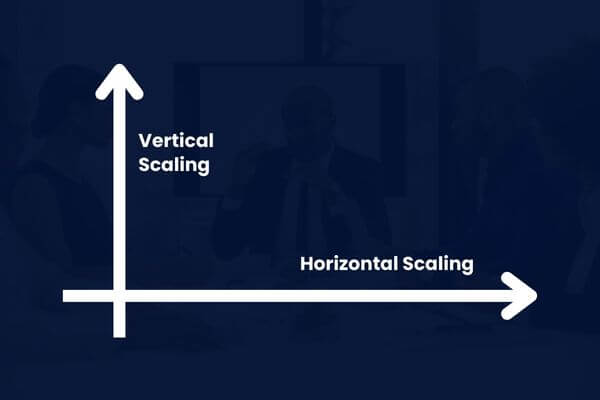
The conventional thinking is that if you want to grow your business, you need to create new products or offers. This method of scaling is called HORIZONTAL expansion.
This is what most entrepreneurs are TRYING to do. They’re trying to launch new things. They think that new things, new products, and new businesses are the solution to scale.
The opposite approach is called VERTICAL expansion.
This is when you go DEEPER in your existing funnel. Yes, you can launch new products, but, they should be in your current funnel. They should all be in unity towards one funnel.
After years of experience scaling businesses, I’m here to tell you that horizontal expansion is the hardest way to scale a business.
Trying to launch new products across different funnels constantly fractured my focus. My products and customer experience were not well-connected.
It was incredibly stressful trying to juggle so many moving pieces rather than going deeper into one core offer.
Once I shifted to vertical expansion by optimizing my core offer, everything changed.
Rather than launching new businesses and offers randomly, I started adding complementary products within my core funnel.
This approach enabled me to enhance my main offering, maintaining my concentration on a singular target audience and their experience.
Once I committed to vertical expansion, scaling became more streamlined and intuitive.
So take it from me – avoid the trap of horizontal expansion if scale and stability are your goals! Going vertical is the wiser path.
Function 1: Acquisition
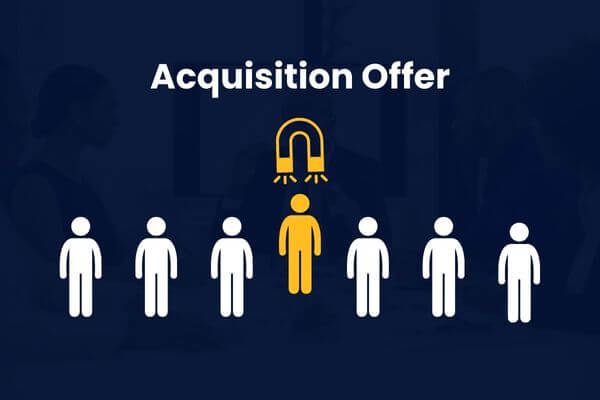
You need something that “acquires” people into your ECO-SYSTEM.
Just think: There’s this BIG world out here; how do you get someone to come into your small world?
That’s the SOLE purpose of an acquisition offer—getting that crucial first set of eyeballs on your business.
Your acquisition offer can come in a variety of formats. Here are some ideas you can explore:
- Free Webinar. A free webinar makes an excellent acquisition offer because it gives you a chance to demonstrate your knowledge and build trust through value-packed content.
Prospects get to hear your voice, see your face, and interact live. This builds a relationship that motivates signups. You can pitch a paid offer at the end to further monetize webinar signups.
- Low Ticket Offer Like a Book. A low-cost book, ebook, or video course acts as a “taste test” of your expertise. The customer gets their feet wet with your advice and teaching for minimal risk.
A book, for example, quickly establishes you as an authority. It serves as a lead generator to acquire customers you can market backend offers to after they consume the book.
- Facebook Group. Groups allow prospects to sample your community and network of followers. This humanizes your brand and builds comfort.
A Facebook group bridges the gap from strangers to someone they know, like and trust. And it can be a gateway to converting group members into customers for your paid programs down the line.
- Free Report. A free report, checklist, blueprint, or guide gives people a preview of your advice in an easy format. Reading a report showcases your knowledge while requiring little time commitment.
As long as you provide real value, a report generates goodwill that earns customer signups. Use it to capture emails for future lead nurturing.
- Discounted Event. Discounting event tickets removes financial barriers to people experiencing your content live. Events build belief through the energy of a crowd.
And it creates a chance to pitch higher-priced offers. Attendees get to meet you in person and mingle with other community members, increasing future conversion rates.
As you can see from our examples, your acquisition offers can be free or paid. No matter which one you choose, the offer should be something that’s an easy (low to no risk) decision so someone can experience you.
Let me tell you now, 9 times out of 10, you’re going to LOSE MONEY on this offer. It’s a loss leader. Its only purpose is to get people into your ecosystem.
Function 2: Liquidation
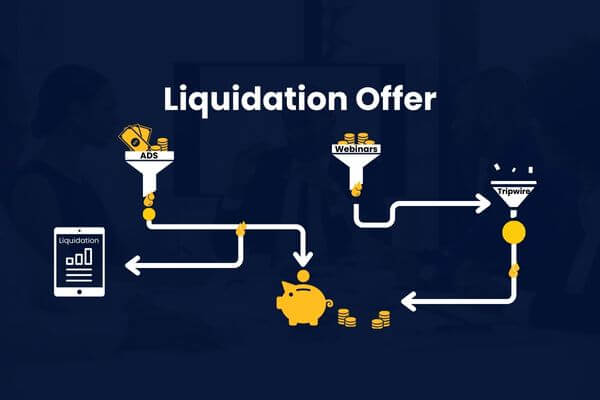
To scale, you need paid traffic.
Can you do it without it? Sure.
Do I recommend you having no life and your fingers falling off doing enough ORGANIC marketing to get to $10 Million – no.
So, if you start paid traffic, you need to “liquidate” your ad cost. This means you need an offer(s) to help you recover your ad spend (the more recovery, the faster the scale).
Here are ideas for liquidation offers:
- BUMPs + Upsells. Order bumps and upsells help recover ad costs by increasing order value. A customer has already made a purchase, reducing friction to buy more. Bumps capture impulse “yes” purchases in the same flow. Upsells after purchase work via reciprocity and social proof. The customer feels good about buying again from a company they trust.
- The $997+ Offer on the Webinar. Pitching a high-ticket offer to webinar signups converts a percentage into buyers. Social proof and scarcity on the webinar help justify the price. And webinar attendees are already warmer leads familiar with your content and value. This liquidates your ad spend from running webinar traffic.
- Event VIP Tickets. VIP event upgrades monetize excited customers. The “FOMO” around exclusivity compels sales. And events attract warm traffic of qualified leads. The customer gets additional value from the VIP experience, making the high price tag worthwhile.
- Tripwires. Tripwire offers are an effective way to boost sales. They’re placed after a lead capture opt-in so you can capitalize on immediate user interest. The customer is already engaged after signing up, so a targeted tripwire converts well. It acts as a “gateway” into a funnel, priming users to buy again. The margins fund paid traffic efforts.
Depending on your scale, I don’t expect 100% of your ad spend to get recovered right away (although it is possible for sure with the right offer)
However, a large chunk can be recovered. This makes paid traffic possible and scalable.
Function 3: The Backend
This is your PROFIT offer or high-ticket offer.
Most businesses that are doing $10 Million+ a year are NOT making money on their front end. They’re smart and understand metrics like:
- 30-day value – The revenue generated from a customer in their first 30 days. This indicates short-term value.
- 60-day value – Revenue generated within the first 60 days. Assesses performance over a longer period.
- 90-day value – Revenue from the first 90 days. Tracks whether you continue monetizing beyond the initial purchase.
- Lifetime value – Total revenue per customer over the entire relationship. The most important metric for long-term profitability.
Why High-ticket Offers Make It Easier to Scale
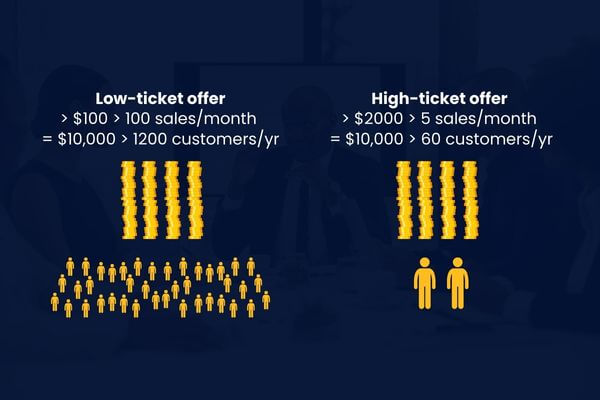
Scaling a business with low-ticket offers can be an uphill battle. You need a constant stream of new customers just to keep the lights on and growth can seem out of reach. High-ticket offers change the math completely.
With premium-priced products and services, you only need a small number of customers to generate a full-time income and grow your business. Less hassle, less overhead, and more profit.
Let’s look at some numbers to see the difference:
- With a $100 product, you need 100 sales per month to make $10,000 in revenue. That’s 1200 customers per year.
- But with a $2000 product, you only need 5 sales per month to earn the same $10,000. That’s just 60 customers for the entire year.
The value of each customer goes way up. So you can scale your income and business faster with fewer clients.
More customers isn’t always the answer to growth. Finding your ideal clients who recognize the value you provide is key. With high-ticket offers, you can focus on quality over quantity.
And devoted, high-paying customers often become raving fans. They help spread the word about your products organically through referrals and word-of-mouth marketing.
High-ticket offers also buy back your time. You spend less energy on sales and fulfillment. And you can reinvest that time on optimizing offers, reaching more of your target audience, and providing incredible service.
So if you’re looking to grow your business and serve a premium clientele, high-ticket offers make the path forward simpler and more sustainable.
Ideas for High-Ticket Offers
So what types of offers can you include for the backend function? Try these:
- Coaching Programs. 1-on-1 coaching is perceived as exclusive and high value. The ongoing personal attention justifies premium pricing. And it builds a deeply loyal customer relationship, increasing lifetime value. Coaching programs can easily scale to multiple $10k+ tiers.
- Consulting Programs. Paid consulting establishes you as an expert advisor. Companies gladly pay high rates for the expertise they lack internally. It offers flexible and scalable revenue without extensive product creation. As long as you overdeliver value, pricing is flexible.
- Additional Courses. Courses allow you to take customers deeper into your expertise. After seeing results from your initial course, customers are eager for more advanced training. Course funnels can scale through tiered pricing and payment plan options.
- Done-For-You Services. Done-for-you services remove pain points by doing the work for the customer. Take tedious tasks off their plate which they will gladly pay to outsource. This establishes recurring revenue and customer retention.
- Agency Services. An agency model allows you to replicate expert services across many clients. You can scale revenue with a smaller team leveraging processes. Customers pay you to achieve results vs. doing the work themselves.
- Masterminds. Masterminds offer exclusive access, community, and expertise customers crave as they scale their success. The intimate peer groups justify premium pricing. Mastermind members often become brand evangelists.
- Events. Live events attract premium ticket sales by creating unique experiences and access. In-person events help you build a movement around your brand and content. VIP upgrades and cross-sells provide strong profit margins.
There are many options – but usually, all of them entail a program that is $5,000 or more. It’s not required, but hell, it makes scaling MUCH easier.
Just one caution: Do not just rob people of money because you can. These programs are expensive, and you need to make them STELLAR. Deliver value. Customer first.
Function 4: The Recurring Offer
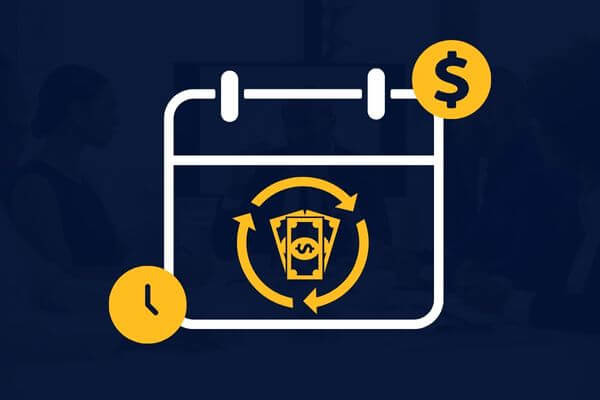
THIS is one that I ignored for 20 years and now, I won’t build a company without it – period.
If you’re below $3M a year, you won’t feel the burn but once you cross $3 Million a year, you’re going to feel something:
The need for STABILITY.
Suddenly, you’ll treasure STABILITY over revenue and profit. As revenue grows, so do your expenses. Your team. Your tools. Your infrastructure.
Starting every month with ZERO revenue is fine when you’re small, it sucks when you’re scaling.
So, you need recurring revenue. Here are some examples:
- Communities. A community like a forum or mastermind builds loyalty and retention. Members are invested in the community itself. This motivates renewing their access monthly or yearly. It’s stable revenue you can count on.
- Membership Sites. Membership sites provide evergreen value that keeps customers wanting to stay subscribed. The site can be updated with new content and tools regularly. This recurring access justifies an ongoing fee.
- SaaS Software. SaaS software builds in automatic recurring revenue. Customers pay to retain access to the tool. As you improve the software over time, churn is reduced. Contracts can increase pricing over time.
- Masterminds. Masterminds cultivate tight-knit groups willing to pay to preserve community access. The scarcity and shared journey retain members for the long haul. This leads to highly predictable recurring revenue.
- Coaching. Ongoing coaching relationships drive recurring revenue through renewals. Satisfied coaching clients often re-enroll for additional months or years. This contributes to revenue stability.
When it comes to recurring revenue, monthly is best. But annual is still better than nothing. The key is offering continual value worthy of an ongoing fee. Help members achieve lasting results and you’ll earn their business for the long term.
Which Offer Do You Include in Your Offer Stack?
Now that you understand the four core functions every offer stack needs, an important next question is – which specific offer should you use for each one?
This depends entirely on your business model, industry, and target audience. You need to intimately understand your ideal customer and what they truly value.
For example, my acquisition offer is a low-ticket course on the strategies of scaling for $5. I know my audience of entrepreneurs and marketers highly values educational content on this topic.
Meanwhile, my liquidation offer is a $500 course on building funnels. I learned through surveys that new subscribers struggle with funnel strategy the most.
My backend offer is a mastermind program at $5,000 per year. Members get access to an exclusive peer community for collaboration and accountability, as well as direct mentorship from experts to take their business to the next level.
And my recurring offer is 1-on-1 coaching at $1,000 per month. I help entrepreneurs establish solid foundations for their online businesses through ongoing personalized guidance and support.
Each offer directly aligns with the goals, problems, and desires of my niche. I created them specifically FOR my audience rather than just using generic templates.
Always start by surveying existing customers and running focus groups with your niche. What do they dream about? What’s missing? Where do they need help?
Armed with these insights, craft acquisition, liquidation, backend, and recurring offers that speak directly to their needs.
People don’t buy when they understand – they buy when they feel understood. Make them say “This company gets me!” and your offer stack will convert powerfully.
1 Offer or 4 - You Pick
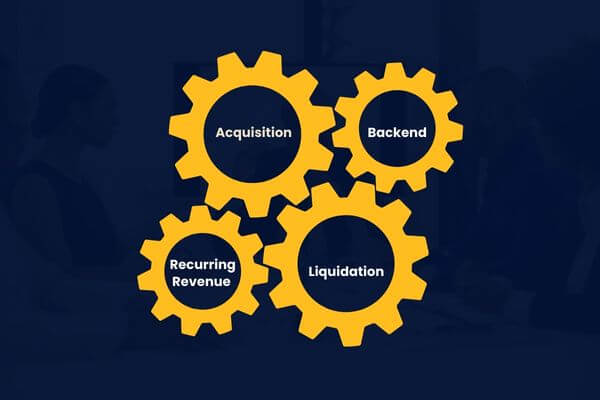
Alright. Those are the 4 offer functions to keep in mind when creating and optimizing your offers.
The reason I say FUNCTIONS is because, technically, you can have just ONE offer that
ticks off all the boxes.
Let’s say…mastermind.
A mastermind can have a funnel where someone comes in and books a “strategy call” <– Acquisition offer.
Then, the cost of the mastermind is enough to liquidate ad spend, make a profit AND it’s recurring so there you go. This is not common though.
I recommend at least 2-3 offers.
But, I recommend AGAINST 8 offers.
If you want to get to $10M – keep it simple and perfect your offer stack to match these functions, then sit there and fine-tune, refine iterate, and SCALE.
If you liked our lessons here, you’ll definitely have a blast inside my FREE Expert Scale Facebook group. I share posts on scaling your business, webinar strategies, email marketing, and all that great stuff.
Plus, you can also ask questions from like-minded entrepreneurs or network with professionals in your niche.
See you on the inside!